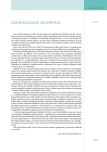Laparoscopic nephropexis – technique with three non-absorbable stitches
Authors:
Milan Hora; Viktor Eret; Petr Stránský; Tomáš Ürge; Jiří Klečka jr.
Authors‘ workplace:
Urologická klinika LF UK a FN Plzeň
Published in:
Ces Urol 2010; 14(1): 32-38
Category:
Original article
Overview
Aim:
When we resolved on starting laparoscopic nephropexy, we decided for the simplest method – laparoscopic transperitoneal with three non-absorbable stitches. We present our opinion with this operation.
Material and methods:
From 12/2004 till 5/2008, nephropexy was performed in 13 women. Twelve times on the right side, once on both sides. The technique of operation: We used 10 mm port for camera through umbilicus and further two working ports (5 and 10 mm). The peritoneum is opened in Toldt’s line. The lateral part of the kidney and the adjacent abdominal wall are cleaned. The kidney is fixed to the abdominal transversal muscle with three or four separate stitches (intracorporal tying) from non–absorbable material – polypropylene, 2/0, needle 31 mm. The peritoneum defect is closed with a running polyglactine suture anchored with absorbable PDS clips. No drain is placed. The patient lies for three days. We recommend avoiding jumping, horse-riding etc for two months.
Results:
Mean age was 34.1 ± 11.8 (20.0 to 61.3) years. Mean BMI 21.9 ± 2.8 (17.3–26.7). Mean time of operation in one side procedure 73.1 ± 13.9 (55–100), bilateral procedure took 155 minutes. Mean follow–up is 26.4 ± 12.7 (2–55) months. All procedures were without blood loss and peroperative and postoperative complications. Long term results: Two were lost for follow–up. Eight are stable, one suffers from recurrent urinary tract infections, and two suffer from pain; one from flank pain in gravidity and after childbirth and one from neuralgic pain in the region of the right hip joint. Four underwent control urography, in one case a residual nephroptosis 4 cm was found, but she is stable.
Conclusion:
Laparoscopic transperitoneal nephropexy with three non–absorbable stitches is easy, fast and relatively efficient. Neuralgia in one case can be due to postoperative irritation of the nerve caused by the stitch. We recommend careful liberation of the abdominal wall enabling safe suturing without damage to nerves.
Key words:
nephropexy, laparoscopy.
Sources
1. Barber NJ, Thomson PM. Nephroptosis and nephropexy – hung up on the past? Eur Urol 2004, 46: 428–433.
2. Bishoff JT, Kavoussi LR. Nephropexy. In: Wein AJ, Kavoussi JR, Novick AC, Partin AW, Peters CA. Campbell-Walsh Urology, 9th edition. Saunders, Elsevier, 2007; 1776.
3. Hübner WA, Schlarp O, Riedl C, Plas E, Reiter WJ. Laparoscopic nephropexy using tension-free vaginal tape for symptomatic nephroptosis. Urology 2004; 64: 372–374.
4. Hahn E. Die operative Behandlung der beweglichen Niere durch Fixation. Zbl Chir 1881; 8: 449–452.
5. Urban DA, Clayman RV, Kerbl K, Figenshau RS, McDougall EM. Laparoscopic nephropexy: initial case report. J Endourol 1993; 7: 27–30.
6. Navrátil P, Vraný M, Louda M. Laparoskopická nefropexe. Čes Urol 1999; 3: 41.
7. Tůma J, Kutal M, Motíl I, Peňáz V, Svoboda P. Laparoskopická nefropexe – moderní a efektivní metoda fixace migrující ledviny. Čes Urol 2003; 7: 54.
8. Kolombo I, Hrubý M, Porš J, Hain J, Kašák P, Berndt D. Retroperitoneoskopická nefropexe pro ren migrans – technické aspekty a výsledek. Čes Urol 2006; 10: 16.
9. Eret V, Hora M, Klečka J. jr, Ürge T. Možnosti laparoskopie v léčbě ptózy ledviny. Čes Urol 2007; 11: 58.
10. Srirangam SJ, Pollard AJ, Adeyoju AA, O‘Reilly PH. Nephroptosis: seriously misunderstood? BJU Int 2009; 103: 296–300.
11. Plas E, Daha K, Riedl CR, Hübner WA, Pflüger H. Long-term followup after laparoscopic nephropexy for symptomatic nephroptosis. J Urol 2001; 166: 449–452.
12. Elashry OM, Nakada SY, McDougall EM, Clayman R. laparoscopic nephropexy: Washington University experience. J Urol 1995; 154: 1655–1659.
13. Fornara P, Doehn C, Jocham D. Laparoscopic nephropexy: 3-year experience. J Urol 1997; 158: 1679–1683.
14. Chueh SC, Hsieh JT, Chen J, Young YL, Chen SC, Tu YP. Retroperitoneoscopic nephropexy for symptomatic nephroptosis. Surg Endosc 2002; 16: 1603–1607.
15. Matsui Y, Matsuta Y, Okubo K, Yoshimura K, Terai A, Arai Y. Laparoscopic nephropexy: treatment outcome and quality of life. Int J Urol 2004; 11: 1–6.
16. Wyler SF, Sulser T, Casella R, Hauri D, Bauchmann A. Retroperitoneoscopic nephropexy for symptomatic nephroptosis using a modified three-point fixation technique. Urology 2005; 66: 644–648.
17. El-Moula MMG, Izaki H, Kishimoto T, Takahashi M, Fukumori T, Kanayama HO. Laparoscopic nephropexy. J Laparoendosc Adv Surg Tech A 2008; 18: 230– 236.
18. Ichikawa T, Yamad D, Takai A, Seagusa M, Aramaki K, Kumon H. Retroperitoneoscopic nephropexy for symptomatic nephroptosis. J Endourol 2003; 17: 767– 770.
19. Vodopija N, Korsic L, Zupancić M, Kramer F, Krstanoski Z, Parać I. Is laparoscopic nephropexy improving the quality of life. Coll Antropol 2007; 31: 689– 692.
Labels
Paediatric urologist Nephrology UrologyArticle was published in
Czech Urology

2010 Issue 1
Most read in this issue
- Aggressive prostate cancer in patients with low PSA
- Anatomical implications of sex reassignment surgery in male-to-female transsexualism and follow-up study
- Laparoscopic nephropexis – technique with three non-absorbable stitches
- Prostate cancer incidence, diagnostic and treatment in HIV-positive patients
